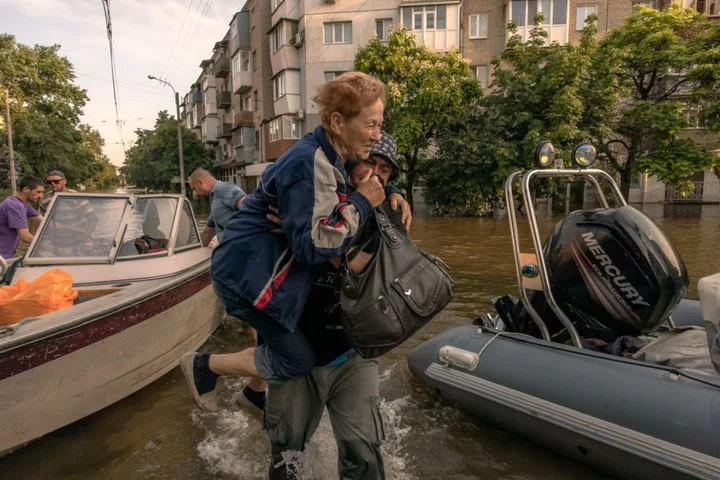Floodwaters have started to recede four days after the destruction of Ukraine’s Kakhovka Dam, laying bare environmental destruction as well as the risk of catastrophic health problems for the downstream population.
Ecological damage alone from the collapse of the dam in its southern region will be more than 55 billion hryvnia ($1.5 billion), although the consequences have just started to unfold, Ukraine’s environment ministry said on Saturday. Ukraine’s border guard warned of a toxic “garbage dump” flowing into the Black Sea.
A third of the national parks in the Kherson region are at risk of disappearing because of plummeting water levels in the Kakhovka reservoir, environment minister Ruslan Strilets said in an emailed statement. The reservoir, which supplied water to millions, has lost 62% of water as of Saturday and water continues to leak, he said. Many rare or unique wildlife habitats have been destroyed or could take years to regenerate.
Ukrainian and European Union leadership have blamed Russia for the blast that wrecked the dam and triggered catastrophic flooding, just as Kyiv’s troops embarked on their long-awaited bid to retake land occupied by Russian forces for over a year. The UK on Saturday said it would provide £16 million ($20 million) in aid to offset the dam destruction. Japan on Friday pledged $5 million in help.
As rescue operations continue, the consequences of one of the largest man-made ecological disasters in Europe in decades continue to evolve. Ukraine is waiting the UN Environment Programme mission’s arrival for help; the UN’s nuclear watchdog has offered specialized technical assistance.
President Volodymyr Zelenskiy criticized international aid agencies in an interview with Germany’s Bild newspaper for what he called a slow response to the humanitarian disaster. Efforts have been complicated by being in a war zone with control split along the Dnipro River between Ukrainian and Russian forces. Kremlin troops launched an artillery strike on Saturday, wounding two volunteers working close to the Dnipro, the region’s governor said, at least the second such incident in three days.
The immediate health risks to the population include the potentially unchecked spread of disease as human cemeteries and areas of animal burials were submerged.
“The impact on the region’s water supply, sanitation systems and public health services cannot be underestimated,” Tedros Adhanom Ghebreyesus, director general of the World Health Organization, said on Thursday.
Some settlements are still covered with floodwaters, while many people closer to the dam lack fresh water. Health officials have told residents not to consume water drawn from wells and ground pumps, as they typically would.
“When people return home, and once the floods have receded, they will possibly go back to using water sources that used to be clean but are now contaminated,” Olivia Mary Headon, from the International Organization for Migration in Ukraine, told the UK Telegraph. “The flooding has brought different contaminants like dead fish, dead animals, and other toxic substances.”
Longer term, Ukraine’s agriculture ministry has warned that the nation’s south may turn “into a desert” as irrigation systems have been destroyed. Another major impact is on the nation’s fish stocks. The Kakhovka reservoir alone was home to 43 fish species, of which 20 species have “industrial significance,” the Ukraine Nature Conservation Group said in a report.
The border guard said Saturday that the Black Sea in the Odesa region is now filling up with dead livestock, parts of houses, home contents, cars and other debris swept down the raging Dnipro. “The sea is turning into a garbage dump and animal cemetery,” they said.
Zelenskiy, who visited the region on Thursday, called contamination of the Black Sea, a vast body of water that borders six countries, a global problem.
Russia occupied the Kherson region in the first days of its full-scale invasion in February 2022. Ukraine managed to push Russian troops from part of the region last November.
Moscow, whose troops are in control of the Kakhovka hydro-power station, has denied it was responsible for the dam’s destruction. And while it initially downplayed threats from the dam collapse, reports are emerging about people drowned in Russian-occupied areas, which have been hit disproportionately by flooding.
In an update on Saturday, the UN’s Office for the Coordination of Humanitarian Affairs said the number of people displaced in areas of Kherson oblast under Ukrainian control is now more than 2,500, with nearly 40 villages and towns “severely affected” and more than 3,620 houses recorded as damaged. Many people have fled the region since the war began.
In contrast, authorities installed by Moscow estimate the number of flooded houses in areas of Kherson oblast under Russian military control at more than 22,000, the OCHA said.

